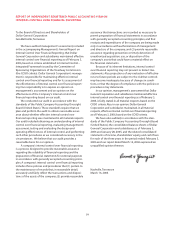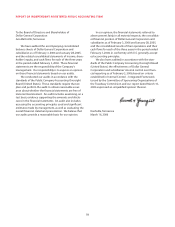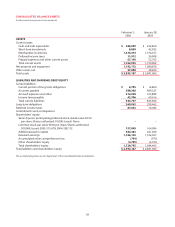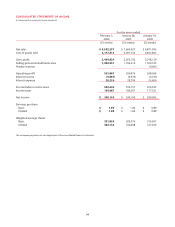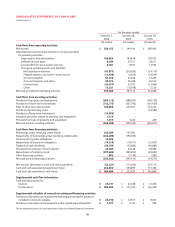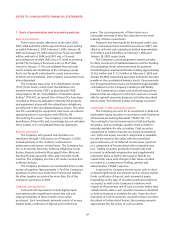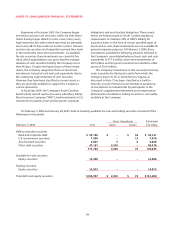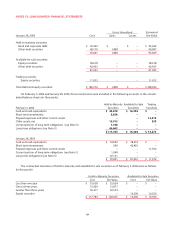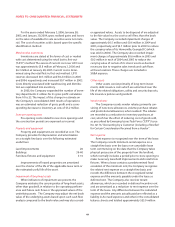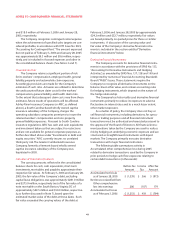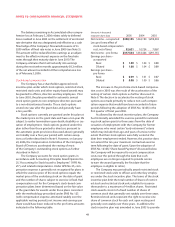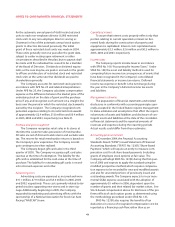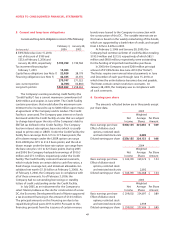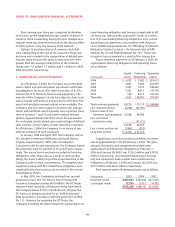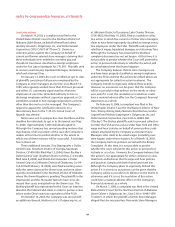Dollar General 2005 Annual Report Download - page 45
Download and view the complete annual report
Please find page 45 of the 2005 Dollar General annual report below. You can navigate through the pages in the report by either clicking on the pages listed below, or by using the keyword search tool below to find specific information within the annual report.
41
NOTES TO CONSOLIDATED FINANCIAL STATEMENTS
and $18.0 million at February 3, 2006 and January 28,
2005, respectively.
The Company recognizes contingent rental expense
when the achievement of specified sales targets are con-
sidered probable, in accordance with EITF Issue No. 98-9,
“Accounting for Contingent Rent.”The amount expensed
but not paid as of February 3, 2006 and January 28, 2005
was approximately $9.3 million and $8.6 million, respec-
tively, and is included in Accrued expenses and other in
the consolidated balance sheets. (See Notes 3 and 7).
Insurance reserves
The Company retains a significant portion of risk
for its workers' compensation, employee health, general
liability, property and automobile claim exposures.
Accordingly, provisions are made for the Company's
estimates of such risks. Actuaries are utilized to determine
the undiscounted future claim costs for the workers'
compensation, general liability, and health claim risks.
To the extent that subsequent claim costs vary from those
estimates, future results of operations will be affected.
Ashley River Insurance Company (or ARIC, as defined
above), a South Carolina-based wholly owned captive
insurance subsidiary of the Company, charges the
operating subsidiary companies premiums to insure the
retained workers' compensation and non-property
general liability exposures. Pursuant to South Carolina
insurance regulations, ARIC has cash and cash equivalents
and investment balances that are subject to restrictions
and are not available for general corporate purposes, as
further described above under “Investments in debt and
equity securities.” ARIC currently insures no unrelated
third-party risk.The Greater Cumberland Insurance
Company, formerly a Vermont-based wholly owned
captive insurance subsidiary of the Company, was
liquidated in 2005.
Fair value of financial instruments
The carrying amounts reflected in the consolidated
balance sheets for cash, cash equivalents, short-term
investments, receivables and payables approximate their
respective fair values. At February 3, 2006 and January 28,
2005, the fair value of the Company’s debt, excluding
capital lease obligations, was approximately $281.0 million
and $275.9 million, respectively (net of the fair value of a
note receivable on the South Boston, Virginia DC of
approximately $49.5 million and $50.0 million, respective-
ly, as further discussed in Note 7), based upon the
estimated market value of the debt at those dates. Such
fair value exceeded the carrying values of the debt at
February 3, 2006 and January 28, 2005 by approximately
$24.2 million and $32.7 million, respectively. Fair values
are based primarily on quoted prices for those or similar
instruments. A discussion of the carrying value and
fair value of the Company’s derivative financial instru-
ments is included in the section entitled “Derivative
financial instruments”below.
Derivative financial instruments
The Company accounts for derivative financial instru-
ments in accordance with the provisions of SFAS No. 133,
“Accounting for Derivative Instruments and Hedging
Activities”, as amended by SFAS Nos. 137, 138 and 149 and
interpreted by numerous Financial Accounting Standards
Board (“FASB”) Issues. These statements require the
Company to recognize all derivative instruments on the
balance sheet at fair value, and contain accounting rules
for hedging instruments,which depend on the nature of
the hedge relationship.
The Company has historically used derivative financial
instruments primarily to reduce its exposure to adverse
fluctuations in interest rates and, to a much lesser extent,
other market exposures.
As a matter of policy, the Company does not buy or
sell financial instruments, including derivatives, for specu-
lative or trading purposes and all financial instrument
transactions must be authorized and executed pursuant to
the approval of the Board of Directors. All financial instru-
ment positions taken by the Company are used to reduce
risk by hedging an underlying economic exposure and are
structured as straightforward instruments with liquid
markets. The Company primarily executes derivative
transactions with major financial institutions.
The following table summarizes activity in
Accumulated other comprehensive loss during 2005
related to derivative transactions used by the Company in
prior periods to hedge cash flow exposures relating to
certain debt transactions (in thousands):
Before-Tax Income After-Tax
Amount Tax Amount
Accumulated net losses
as of January 28, 2005 $ (1,539) $ 566 $ (973)
Net losses reclassified from
Other comprehensive
loss into earnings 286 (107) 179
Accumulated net losses
as of February 3, 2006 $ (1,253) $ 459 $ (794)


